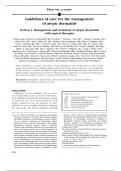Summary
Summary Guidelines_of_care_for_the_management_of_atopic_dermatitis_section 2
- Course
- Institution
FROM THE ACADEMY Guidelines of care for the management of atopic dermatitis Section 2. Management and treatment of atopic dermatitis with topical therapies Work Group: Lawrence F. Eichenfield, MD (Co-chair),a,b Wynnis L. Tom, MD,a,b Timothy G. Berger, MD,c Alfons Krol, MD,d Amy S. Paller, MS,...
[Show more]



